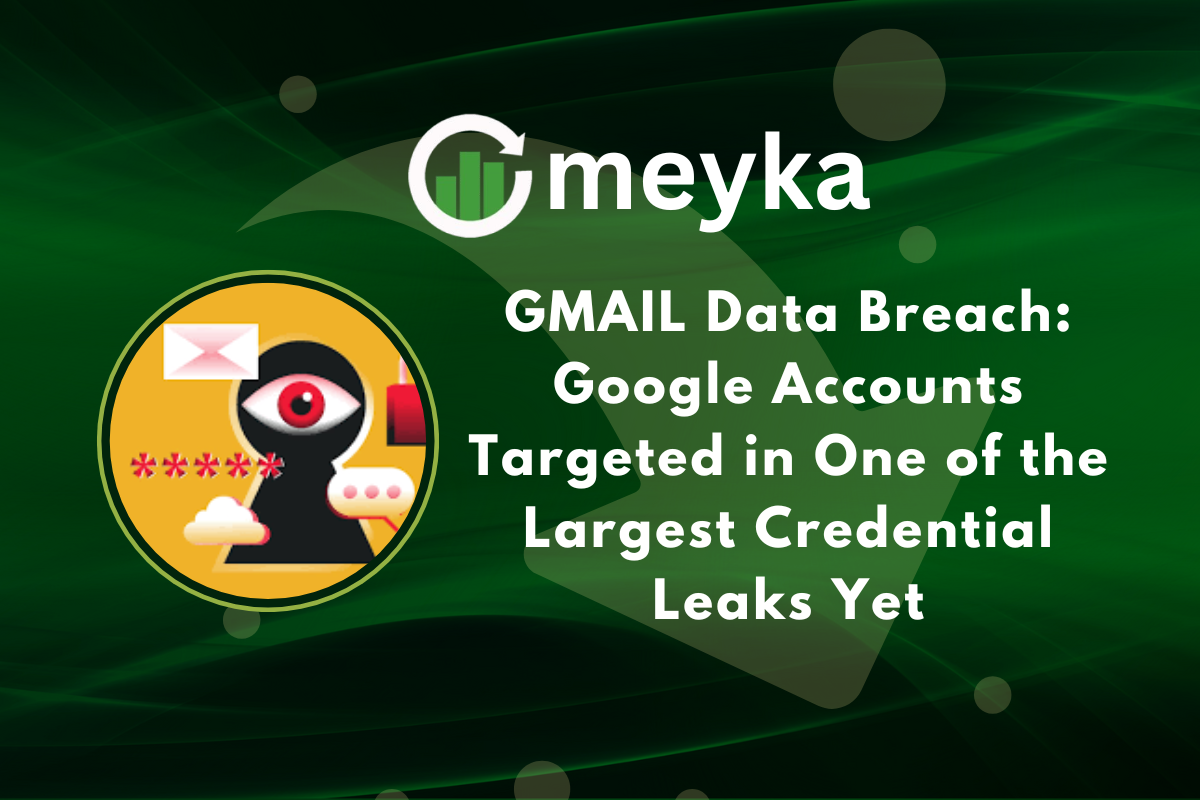GMAIL Data Breach: Google Accounts Targeted in One of the Largest Credential Leaks Yet
A massive GMAIL Data Breach has reportedly exposed the passwords of over 183 million Google accounts, marking one of the largest credential leaks in recent years. The breach, confirmed by cybersecurity reporting, has left millions of Gmail users vulnerable to phishing attacks and identity theft.
According to initial reports, the leaked data surfaced on underground forums and includes email addresses, passwords, and partial personal identifiers. Google has urged users to enable two-factor authentication (2FA) and change passwords immediately.
But how did such a large-scale leak happen, and what can users do right now to stay safe?
What Happened in the GMAIL Data Breach
Researchers and journalists say the leak contains roughly 183 million compromised Gmail credentials shared across multiple dark web marketplaces. The dataset appears to be a combo list, a merged collection of records taken from past breaches and fresh phishing yields.
Analysts found email addresses, hashed and in some cases plain passwords, plus login metadata that makes account takeover easier. This bucketed data is now widely distributed in criminal circles and is being used to test logins across many services.
What makes this Gmail breach particularly dangerous? The real risk isn’t that Google was hacked directly. It’s that stolen credentials from many sources were combined and reused against active services. When passwords are reused, one leak can unlock dozens of accounts, including banking, cloud storage, and social media.
How Hackers Exploited Google Accounts in the GMAIL Data Breach
Cybersecurity teams say attackers relied on credential recycling and automated tools. These tools, increasingly powered by AI-enhanced password matching, sift huge lists for credentials that still work.
The attackers then run credential stuffing attacks: automated login attempts that play stolen username/password pairs against Gmail and other services.
Much of the raw data was not taken from Google servers, but from successful phishing campaigns, third-party app leaks, and unsecured databases that were later aggregated.
As one security commentator put it on social media, “The Gmail breach shows how exposed our digital lives are when one weak password can open dozens of doors.” This problem is compounded when threat actors apply AI to correlate old leaks with new patterns to find active accounts.
Google’s Response to the GMAIL Data Breach
Google has publicly stated that its internal systems were not directly compromised. Instead, the company says the leaked credentials appear to come from external sources and user behavior, such as password reuse or falling for phishing.
Google confirmed it is monitoring suspicious activity, running automated security checks, and forcing password resets for accounts flagged as high risk. Impacted users may receive alerts and temporary lockouts while their identity is verified.
What should Gmail users expect next? Expect account verification prompts and security alerts if your address is on the leaked list. Google’s automated protections will nudge many users to reset passwords and to enable 2-step verification (2SV) or passkeys where possible.
Impact of the GMAIL Data Breach: Millions of Users at Risk
Security analysts estimate that over 100 million of the exposed Gmail credentials remain active. That makes them ripe targets for scams, phishing campaigns, and direct account takeovers.
Threat actors often send follow-up phishing emails that appear to come from Google Support or an internal admin to harvest more information.
The breach also raises concerns about identity theft, financial fraud, and targeted attacks against professionals and public figures whose accounts were included.
Even accounts not directly exposed can be affected. Attackers can impersonate Gmail users, spoof messages, or launch social-engineering attacks that trick contacts into handing over more data. The fallout is rarely confined to one platform.
Expert Advice: How to Protect Yourself After the GMAIL Data Breach
Simple, immediate steps reduce risk substantially:
- Change your Gmail password now. Use a long passphrase or a password manager to generate unique passwords.
- Enable two-factor authentication (2FA/2SV). Use authenticator apps or passkeys instead of SMS when possible.
- Check breach databases such as Have I Been Pwned to see if your address appears in the leaked collection.
- Avoid clicking unknown links. Treat any email asking you to “confirm” account details as suspicious.
- Run Google’s Security Checkup from your account dashboard and remove unrecognized devices and apps.
Think your Gmail is safe because you use the same password everywhere? Think again. Reuse is the single largest driver of credential stuffing success.
Google’s Broader Security Strategy and User Responsibility
Google continues to invest in AI-driven threat detection and offers the Advanced Protection Program (APP) for high-risk users, which enforces hardware security keys and stricter third-party access.
These systems help, but they are not a replacement for basic cyber hygiene. Security is a shared responsibility: tech companies must build safer systems while users must adopt stronger practices.
Does Google automatically protect every user? Largely yes, through background protections. But proactive steps, unique passwords, multi-factor auth, and cautious email behavior remain essential.
The Scale of the GMAIL Data Breach in Numbers
- 183 million Gmail credentials reported exposed.
- ~40% estimated still active, according to security analysts’ early estimates.
- Millions of phishing attempts traced to the leaked data within days.
- Affected regions include North America, Europe, Asia, and the Middle East. Law enforcement and security teams are investigating dark web marketplaces hosting the lists.
What Makes This GMAIL Data Breach Different
This incident is not a single-platform compromise. It’s an aggregation of many past leaks and live phishing yields. That aggregation creates a credential tsunami: a master list that can be replayed across multiple services. The real novelty is how attackers use automation and AI to sift for active accounts at scale. The result is a faster, broader, more damaging wave of account takeovers.
In short, this isn’t just another data leak; it’s a wake-up call for the entire digital world.
The Takeaway from the GMAIL Data Breach
The GMAIL Data Breach underscores the danger of password reuse and overreliance on convenience. Google’s systems remain secure in their core, but aggregated stolen credentials make individual users the weak link.
The best defense is simple: change passwords, enable 2FA, and stay vigilant against phishing and password theft. Your Gmail password is not just a login; it’s the key to your online life.
FAQ’S
It means your password appeared in leaked databases exposed by hackers, putting your account at risk of unauthorized access.
Yes, cybersecurity researchers estimate that over 16 billion credentials have been exposed globally through various data breaches.
Yes, reports confirm a massive Gmail-related data leak involving around 183 million compromised accounts shared on hacker forums.
Google is urging users to switch to stronger authentication like passkeys because reused or weak passwords are easily stolen or guessed.
Disclaimer
The content shared by Meyka AI PTY LTD is solely for research and informational purposes. Meyka is not a financial advisory service, and the information provided should not be considered investment or trading advice.”






